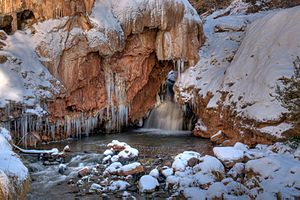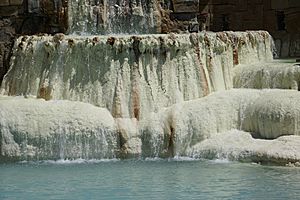Native Americans and hot springs facts for kids

Native Americans have a very long and special connection with hot springs, geysers, and other natural warm water features. For thousands of years, these amazing places have been important to them.
There is proof that many big hot springs across the Americas were visited and used by local Native American groups. Scientists have found old tools and objects near these hot springs, showing that people have been using them for a very long time, even thousands of years. Native Americans saw hot springs as sacred, healing places.
Native Americans always treated these natural wonders as special, holy sites. If different tribes, even those who were at war, arrived at the same hot spring, all fighting would stop. They believed they were on sacred ground where peace was important. Native peoples in the Americas have used hot springs and other warm water spots for about 10,000 years. These natural springs offered healing mineral water, warmth, and a way to get clean.
Contents
Why Were Hot Springs Important to Native Americans?
Hot springs were much more than just warm pools of water for Native Americans. They were seen as gifts from nature, offering many benefits.
Healing and Health Benefits
The warm, mineral-rich water in hot springs was believed to have special healing powers. People would bathe in them to help with different sicknesses or injuries. It was like a natural hospital or spa.
Sacred and Peaceful Places
Many tribes considered hot springs to be sacred. They were places for spiritual ceremonies and quiet reflection. Because they were so special, hot springs often became neutral zones where different tribes could meet peacefully, even if they were usually enemies. All conflict would stop when they were on this holy ground.
Warmth and Cleansing
Beyond healing, hot springs provided natural warmth, which was especially helpful in colder climates. They also offered a way for people to clean themselves, which was important for hygiene and comfort.
Stories of Native American Hot Spring Use
Many hot springs across North America have long histories of use by Native American tribes. Here are a few examples that show how important these places were.
Tonopah Hot Springs: Water for Us
In Arizona, there are natural hot springs near a town called Tonopah. The name "Tonopah" comes from the Western Apache language, meaning "Water For Us" or "Water For You." Even though there are no old homes right next to the springs, many ancient tools have been found there. Things like holes for grinding grain, pieces of pottery, and lots of arrowheads suggest that groups like the Hohokam people visited this spot often for many years. It was also a popular place for hunting.
Sleeping Child Hot Springs: A Safe Haven
In the Rocky Mountains of Montana, near what is now Missoula, there's a hot spring with a special story. In the 1870s, the Nez Perce people used this hot spring as a safe place to avoid American soldiers. A group of them left their babies at the warm springs to keep them safe from a possible battle. When they returned, they found the babies sleeping peacefully, "protected by the natural hot springs." This event is why the place is now called Sleeping Child Hot Springs.
Saratoga Springs: Healing Waters in New York
In New York, the area known as Saratoga Springs has about 18 different hot springs. The Iroquois and Mohawk peoples used these springs, especially the High Rock Spring. The Mohawks called this area Kayaderosseras. They used the springs for cleansing their bodies and for healing purposes.
Hot Springs, Arkansas: Valley of the Vapors
The Hot Springs area in Arkansas has 47 thermal springs. These springs were first used by very early Native American groups called Paleo-Indians, and later by many other tribes. These springs were known as the Valley of the Vapors. They were seen as a sacred and healing place, and also as a neutral zone where "warriors of all tribes could rest and bathe" in peace. After Europeans arrived, many Native American groups were moved west, but tribes like the Quapaw, Cherokee, and Natchitoches later lived in the area.


